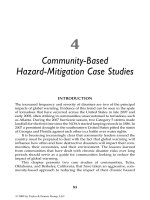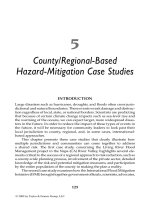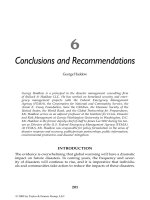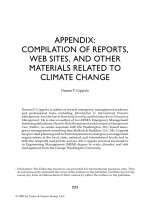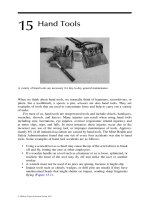Lecture Sales and distribution management: Chapter 15 - Krishna K Havaldar, Vasant M Cavale
Bạn đang xem bản rút gọn của tài liệu. Xem và tải ngay bản đầy đủ của tài liệu tại đây (591.1 KB, 56 trang )
Chapter
15
Market Logistics & Supply Chain
Management
SDM – Ch 15
Tata McGraw Hill
1
Learning Objectives
• Principles of materials management, logistics
and supply chain management
• Logistics interface with other functions
• Inventory management principles and
systems
• Warehousing management fundamentals
• Transportation management practices
• How IT enables the logistics function
• Understand about the performance
measurement of the logistics function
SDM – Ch 15
Tata McGraw Hill
2
Materials Management
• Materials forms the largest single cost item in
most manufacturing companies – needs to be
carefully managed
• Materials management function includes
planning and control, purchasing and stores
and inventory control
• Materials management is the precursor to
logistics and supply chain management
Logistics……
SDM – Ch 15
Tata McGraw Hill
3
Logistics Defined
• Logistics means having the right thing, at
the right place, at the right time
• The procurement, maintenance, distribution
and replacement of personnel and materials –
Webster’s Dictionary
• The science of planning, organizing and
managing activities that provide goods or
services – Logistics World, 1997
SDM – Ch 15
Tata McGraw Hill
4
Logistics
• Functions: planning, procurement,
transportation, supply and maintenance
• Processes: requirements determination,
acquisition, distribution and conservation
• Business: science of planning, design and
support of business operations of
procurement, purchasing, inventory,
warehousing, distribution, transportation,
customer support, financial and human
resources
SDM – Ch 15
Tata McGraw Hill
5
Scope of Logistics
•
•
•
•
•
•
•
•
Choice of markets
Procurement
Plant location and layout
Inventory management
Location and management of warehouses
Choices of carriers, mode of transport
Packaging decisions
Relevant to all enterprises: manufacturing,
Government, Institutions, service
organisations
SDM – Ch 15
Tata McGraw Hill
6
Components of LOG
Management
Input
•Natural
Resources
(land, facilities
Equipment)
•HR
•Finance
•Information
SDM – Ch 15
Logistics Activities
Output
Customer service
Demand forecasting
Distribution
Communications
Inventory control
Materials handling
Order processing
Parts and service support
Plants and warehouse selection
Procurement
Packaging
Return goods handling
Salvage and scrap disposal
Traffic and transportation
Warehouse and storage
Tata McGraw Hill
•Marketing
Orientation
(competitive
Advantage)
•Time and
Place utility
•Efficient move
to customer
7
Links and Flows
General material flow/ service flow
Information flow
Information flow
Customer’s
customer
Customer
Lead Firm
Supplier’s
supplier
Supplier
General cash flow
Outbound / Downstream logistics
SDM – Ch 15
Inbound / Upstream logistics
Tata McGraw Hill
Source: ICFAI
8
Logistics and Marketing
• Interface on:
–
–
–
–
–
–
Product design and pricing
Customer service policies
Sales forecasts and order processing
Inventory policies and location of warehouses
Channels of distribution and despatch planning
Transportation to reach products to customers
• Production wants larger production runs to
minimise time spent on set up changes on the
machines. Marketing wants smaller runs of a
variety of products.
SDM – Ch 15
Tata McGraw Hill
9
Source: Michael Porter
The Value Chain
S
U
P
P
P
O
R
T
Company Infrastructure
Organisation, people, methods
margin
Systems & technology
Procurement
Inbound
Operations
logistics
Outbound Marketing
logistics
& sales
Service
margin
SDM – Ch 15
Primary
activities
Tata McGraw Hill
10
Logistics Plan Outline
• Internal analysis (current position)
–
–
–
–
–
–
Organisation
Human resources
Transportation
Relations with internal customers
Quality of product
Quality of Service
• External / situation analysis
– Competitor logistics performance
– Trends
– External environment / economy
– Public, private and contract warehouse
– Public, private and contract carriage
SDM – Ch 15
Tata McGraw Hill
11
Principles of Logistics Excellence
Strategic
Operational
Link logistics to corporate
strategy
Organise comprehensively
Use the power of information
Emphasise human resources
Form strategic alliances
Focus on financial
performance
Target optimum service levels
Manage the details
Leveraging logistics volumes
Measure and react to
performance
SDM – Ch 15
Tata McGraw Hill
12 Alling & Tyndall
Logistics Focus Areas
Customer service related
Packaging
Order processing
Spare parts and service support
After sales Customer service
support
Demand forecasting
Distribution communications
Return goods handling
Operations related
Plant and warehouse site
location
Procurement
Inventory control
Materials handling
Salvage and scrap disposal
Traffic and transportation
Warehousing and storage
Logistics may be confined to the company whereas SCM extends beyond
SDM – Ch 15
Tata McGraw Hill
13
Supply Chain Management
• Business context:
–
–
–
–
Globalization of the market place
Advances in technology
Increasingly demanding, informed customer base
Purchase decisions on dimensions of quality, price
and time
• Innovative supply chain:
–
–
–
–
To meet customer driven challenges
To reduce costs
Improve service levels
Enhance speed to market
SDM – Ch 15
Tata McGraw Hill
14
Supply Chain Integration
• Optimising the supply chain requires
supplier and customer involvement to
integrate processes, policies, systems,
database and strategies between
diverse trading partners
SDM – Ch 15
Tata McGraw Hill
15
Supply Chain Integration
Customer Analysis
Order Fulfillment
Storage &
Transportation
Purchasing/Supplier
Partnering
Integrated
Supply Chain
Management
Demand & Lead
Time Management
Manufacturing/
Remanufacturing/
Assembly
SDM – Ch 15
Inventory Management and
control
Materials
Management
Tata McGraw Hill
Inventory management…
16
Why Carry Inventory?
• Support production requirements
• Support operational requirements
• Maximize customer service – ensure
availability when needed – protect
against uncertainty
• Hedge against marketplace uncertainty
• Take advantage of order quantity
discounts
SDM – Ch 15
Tata McGraw Hill
17
Functions of Inventory
• Inventory serves as a buffer between:
– Supply and demand
– Customer demand and finished goods
– Requirements for an operation and the
output from the previous operation
– Parts and materials to begin an operation
and the suppliers of the materials
The shock absorber of business !
SDM – Ch 15
Tata McGraw Hill
18
Factors Which Drive Inventory
• Target service level parameters
• Lot sizing practices
• Safety stock and safety time
conventions
• Volume discounts and purchase
arrangements
• Seasonal build up needs
SDM – Ch 15
Tata McGraw Hill
19
Categories of Inventory
• Anticipation – built in anticipation of future
demand – peak season, strike, promotion
• Fluctuation (safety) – to cover random,
unpredictable fluctuations in supply and
demand and lead time – to prevent disruption
in operations, deliveries etc
• Lot-size – to take advantage of quantity
discounts, reduce shipping, set up and
clerical costs – also called cycle stock
SDM – Ch 15
Tata McGraw Hill
20
Categories of Inventory
• Transportation – pipeline or movement
inventories – to cover the time needed to
move from one point to another – factory to
distribution point for example
• Hedge – for materials where prices are
volatile
• Maintenance, repair and operating supplies
(MRO) – to support M and O – spare parts,
lubricants, consumables etc
SDM – Ch 15
Tata McGraw Hill
21
Types of Inventory
• Obvious….
– Raw materials
– Work-in-process
– Finished goods – of primary concern to
marketing
– Maintenance, repair and operating (MRO)
supplies
– In-transit, pipeline
Performance measures…
SDM – Ch 15
Tata McGraw Hill
22
Performance Measures
• Inventory turns = Annual cost of goods
sold /average inventory in value
• Days of sales = inventory on hand /
average daily sales
SDM – Ch 15
Tata McGraw Hill
23
Types of Inventory Systems
• Pure Inventory – when and how much to
order. RM procurement. Simple
manufacturing operations
• Production Inventory – finite production
rates. Demand fluctuation. Products compete
for manufacturing capacity
• Production – distribution Inventory –
compete for production capacity. Geographic
placement of inventory for best service of
demand
SDM – Ch 15
Tata McGraw Hill
24
Types of Classification
• ABC category – most common for all
• HML - high, medium, low - similar
• FSND – fast moving, slow moving, nonmoving, dead – spare parts / FG
• SDE – scarce, difficult, easy to obtain –
procurement / Spares
• GOLF – govt, ordinary, local, foreign source –
procurement / Spares
• VED – vital, essential, desirable – spare parts
/ FG
• SOS – seasonal, off-seasonal - commodity
SDM – Ch 15
Tata McGraw Hill
25



